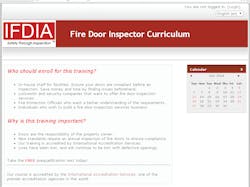I was given the opportunity to take the IFDIA Swinging Fire Door Inspector online course. I began by successfully completing the free Pre-Qualification Quiz. This quiz is to help determine if you have sufficient knowledge in the area of listed and labeled fire door assemblies to consider taking the Advanced Swing Type Fire Door Inspector Course. This fee-based, advanced, accredited course provides a basis for becoming a Fire Door Inspector.
For locksmiths who prefer a hands-on education, ALOA and the IFDIA have combined efforts to offer in-person classes. Contact Associated Locksmiths of America, www.aloa.org, for more information.
The web based Swinging Type Fire Door Inspector Course curriculum is divided into Sections and Chapters. Each component is written in simple, descriptive language, making the class material easier to understand. At the end of each chapter, quiz questions must be answered correctly, in order to proceed through the course. Each person taking the course has two weeks to complete. No text books or code books are required.
The landing page for the eLearning course is located at this web address: http://www.ifdia.org/elearning.
If you were on this page and scrolled down, you would see the different course offerings. The only one highlighted that you can click, initially, is the free Pre Qualification Exam. Once you successfully pass, you are offered the opportunity to purchase and take the course. A minimum of 80 percent on the exam is required. If you score between 60 and 79 percent on the 15-minute timed test of 30 questions, you will be shown a link where you can download a free copy of the Basic Guide to Fire Door Inspections. This free guide will help you learn more about fire doors, in the hope that you can re-take the pre-qualification test and enter the course.
Integrating the different building and safety code sections, such as fire door inspections, are up to the discretion of each state, territory and District of Columbia, when determining what parts of the NFPA 80 Standards are adopted. Often these reference standards are not edited and become part of the state law by blanket reference.
Based on the International Code Council’s table titled, International Codes-Adoption by State, 42 states have adopted on some level the 2009 IBC or IFC or later which contains the reference to the 2007 Edition of NFPA 80. The ICC has a web page where you can check to see what codes are adopted and enforceable in your jurisdiction. The web address for this table-so you can bookmark it if needed- is: http://www.iccsafe.org/gr/Documents/stateadoptions.pdf
Additionally, the ICC has a web page with an interactive map. This allows for you to click on any state to find out what the latest code adopted is. The map can be found here: http://www.iccsafe.org/gr/Pages/adoptions.aspx
Fire door inspections were introduced into the 2007 edition of the National Fire Protection Association (NFPA) 80 Standard for Doors and Other Opening Protectives. The 2007 NFPA 80 Standard state:
"5.2.1 Fire door assemblies shall be inspected and tested not less than annually and a written record of the inspection shall be signed and kept for inspection by the AHJ."
For the 2013 edition of the NFPA 80, the standard was revised to read:
"5.2.4.1 Periodic inspections and testing shall be performed not less than annually. Fire door assemblies shall be visually inspected from both sides to assess the overall condition of the door assembly."
Because of the scope of this standard, the Local Authority Having Jurisdiction (LAHJ, usually a building code official or fire marshal) cannot personally inspect all the fire door assemblies on commercial and institutional buildings in their jurisdiction. To makes sure these inspections do not place too heavy a burden on the LAHJ, where they might become overwhelmed and not require inspections, the 2007 NFPA 80 Standard for Doors and Other Protectives Section states:
"5.2.3.1 Functional testing of fire door and window assemblies shall be performed by individuals with knowledge and understanding of the operating components of the type of door being subject to testing."
NFPA 80 2010 edition defines a qualified person as:
"A person who, by possession of a recognized degree, certificate, professional standing, or skill, and who, by knowledge, training, and experience, has demonstrated the ability to deal with the subject matter, the work, or project."
This standardizes the role of the fire door inspector (FDI). The FDI is responsible for inspecting listed and labeled fire door assemblies. He or she record and file a comprehensive report of inspection findings to the authority having jurisdiction. Fire Door Inspectors do not determine if the listed and labeled fire door assemblies meet code compliance.
An FDI is hired by the building owner to inspect their listed and labeled fire door assemblies, as required by the section in NFPA 80 2007-or in those locations where the code standard has been adopted. The role of the building owner is to provide plans, blueprints and/or hardware schedules that indicate the locations of the listed and labeled fire door assemblies. The building owner will provide access to the buildings. They are responsible to ensure listed and labeled fire door assemblies are compliant, or if not, they ensure all work required will be performed.
The role of the LAHJ is to review the inspection report and determine if the listed and labeled fire door assemblies meet code compliance. The LAHJ may issue permits as determined by jurisdiction and maintains records of buildings that have been inspected.
To provide security professionals with information, support services and expertise necessary to compete, the International Fire Door Inspector Association (IFDIA) offers a web based Fire Door Inspector course or an in-person hands-on course. The IFDIA curriculum is accredited by the International Accreditation Services (IAS), a subsidiary of the International Code Council (ICC), an association that produces building, electrical, life safety, etc. codes that have been adopted by the fifty states and the District of Columbia.
When a person completes the course, they are offered free membership in the association. The association has a group on LinkedIn, as well as a Facebook page, where people can leave comments, ask questions and follow discussions on fire door inspection topics. To find these groups, just type the association name into the Facebook or LinkedIn search field. For more information or to become a member, visit www.ifdia.org.
Those who successfully complete the course receive a PDF of the Field Guide, which is color, searchable by key word or phrase version that can be downloaded to a compatible Smartphone, tablet, laptop or desktop computer. The successful locksmiths will receive an Identification Card upon joining the Association.
The goal of the IFDIA is there to help graduates promote their fire door inspection businesses. Power Point presentations are available. The IFDIA has a toll free telephone number for technical questions. If you need some technical help, where you need something in writing, the IFDIA is able to provide you with resources.






